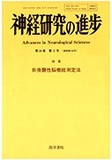Japanese
English
- 有料閲覧
- Abstract 文献概要
- 1ページ目 Look Inside
はじめに
Positron Emission Tomography(PET)による研究成果を,Single Photone Emission Computed Tomography(SPECT)による方法に還元してそれを広く普及させることは,核医学研究の理想である。PETによって得られたさまざまな脳循環代謝測定に関する成果のうちSPECTに還元されたもののなかでは,脳血流シンチがもっとも普及している。従来の脳の核医学的検査法は,血液脳関門の破壊を主な集積の原理とした99mTC製剤(99mTc-DTPAや99mTC-pertechnetateなど)を用いるいわゆる脳シンチグラフィと,133Xeによる脳循環測定法とが主流をしめていた。前者はX線CTの開発と普及により急速に衰え,後者のみが,脳血流をみるための機能検査としていまも活用されている。しかし,133Xeには,散乱線による画質の低下や低解像力という問題があり,より正確な脳循環のパラメーターを算出するための放射性医薬品の開発が望まれていた。
Recently, two kinds of radiopharmaceuticals have been developed to represent the biodistribution of regional cerebral blood flow, which are N-isopropyl-p-[123I] iodoamphetamine (IMP) and 99mTc-hexamethylpropylene-amine-oxime (HMPAO). In this paper, I mentioned the characteristics, clinical usage and limitation of these two radiolabeled agents. The advantage of 123I-IMP is that it has high first-pass extraction and long retention in brain tissue, hence it can be used to measure the absolute values of regional cerebral blood flow (rCBF).

Copyright © 1994, Igaku-Shoin Ltd. All rights reserved.


